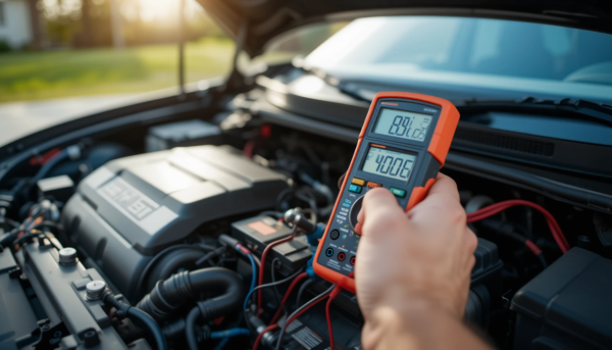How to find a parasitic battery drain easily—learn step-by-step fixes, causes, and tools to stop battery problems for good.
How to Find a Parasitic Battery Drain 🔍
Is your car mysteriously dying overnight—no lights left on, no warning? You’re not alone. A parasitic battery drain is sneaky, frustrating, and often misunderstood. But the good news? You can find and fix it—even if you’re not a mechanic.
Let’s break it down in plain English, with tools you might already have in your garage. No fancy tech degree needed. 😉
What Is a Parasitic Battery Drain? 🧲
A parasitic drain happens when something in your car keeps using power even after the ignition is off. It slowly pulls energy from your battery—until there’s nothing left.
This could be:
- A faulty glovebox light
- An aftermarket stereo system
- A bad relay or sensor
- Or even a stuck switch in your trunk
In normal cases, your battery should only lose a tiny bit of power when parked. But with a parasitic draw, that trickle turns into a full drain.
Why It’s a Big Deal 🚨
Think it’s just a dead battery? Think again. Ignoring a parasitic drain can cause:
- Frequent jump-starts (ugh!)
- Battery damage
- Stranded mornings
- More expensive repairs
Worse, if you keep replacing the battery without solving the real issue—you’re just throwing money down the drain. 💸
Signs You Have a Parasitic Drain 👀
Wondering if you’re dealing with this issue? Look for these red flags:
- Battery dies after sitting overnight
- You hear faint buzzing or clicking after shutting the car off
- Interior lights or dash components don’t turn off
- Car won’t start despite a new battery
- Alarm or infotainment glitches randomly
Tools You’ll Need for Diagnosis 🧰
You don’t need to break the bank. Here’s what helps:
| Tool | What It Does | Approx. Cost |
|---|---|---|
| Multimeter | Measures electrical draw | $15–$40 |
| Socket set | Removes battery terminal | $10–$30 |
| Fuse puller | Helps remove fuses safely | $5–$10 |
| Clamp meter (optional) | Checks current without removing battery | $30–$70 |
👉 Tip: Many auto parts stores loan out tools for free. Just ask!
Step-by-Step: How to Find the Drain 🔎
Here’s the exact process to follow:
1. Make Sure the Battery Is Fully Charged 🔋
Start fresh. A low battery can give false readings. Use a charger or get a jump, then let it charge completely.
2. Shut Off the Car and Remove the Key
Let it sit for at least 30 minutes. This gives modules time to go into sleep mode.
3. Disconnect the Negative Battery Terminal
Always remove the negative cable first. This breaks the circuit safely.
4. Connect the Multimeter in Series
- Set it to DC Amps (A).
- Connect one lead to the negative battery post.
- Connect the other to the negative cable.
⚠️ Be careful not to start the car while the multimeter is in place. You could blow a fuse in your meter.
What’s a Normal Draw? 📉
Here’s a simple guide:
| Current Draw (Amps) | What It Means |
|---|---|
| 0.02–0.05 A (20–50 mA) | Normal range |
| 0.10 A (100 mA) | Borderline high |
| 0.25 A (250 mA) or more | Definitely a drain |
If you’re seeing a high number—say, over 100 mA, you’ve got a parasitic issue.
Time to Pull Fuses 🧪
Here’s how to isolate the culprit:
- Leave the multimeter connected.
- Start pulling one fuse at a time.
- Watch the reading on your multimeter.
- When the number drops significantly, you’ve found the problem circuit.
📌 Pro Tip: Start with interior fuse boxes before moving to the engine bay.
Understanding Fuse Labels 🧾
Not sure what each fuse does? Check your owner’s manual or the diagram inside the fuse box cover.
| Fuse Label | Common Component |
|---|---|
| RADIO | Stereo, infotainment |
| BCM | Body control module |
| INT LAMP | Dome lights, map lights |
| PWR SEAT | Power seats |
| ACC | Accessories circuit |
What to Do After Finding the Problem Circuit 🔧
Once you’ve found the draining fuse:
- Remove it and see if your battery stays charged overnight.
- Reinstall the fuse and test each component it controls.
- Unplug items one-by-one to narrow it down.
Common troublemakers:
- Aftermarket alarms
- Phone chargers left plugged in
- Dash cams
- Power seat motors
- Glove box or trunk lights stuck on
Fix or Replace the Faulty Component 🛠️
Depending on what you found, your fix might include:
- Replacing a faulty relay
- Cleaning or adjusting a door switch
- Unplugging aftermarket gear
- Replacing an old module
💡 Stuck? A mechanic can help with special tools.
Can a Parasitic Drain Come and Go? 🤔
Yes. Intermittent drains are the trickiest. They can vanish for days, then suddenly come back. You might need to:
- Use a clamp meter and leave it overnight
- Install a dash cam with parking mode to monitor lights/sounds
- Keep a battery disconnect switch handy as a short-term fix
What If You Don’t Have a Multimeter? 🪫
Try this old-school method:
- At night, park in a dark garage.
- Wait for the car to sleep.
- Look inside—do any lights stay on?
- Feel electrical components like relays or modules—are any warm?
It’s less accurate but can help narrow things down.
How Long Should a Healthy Battery Last Parked? ⏳
A healthy car battery should last:
- 2–4 weeks without driving in most cases
- Just a few days if you’ve got a drain
If your battery dies in 24–48 hours, the problem’s urgent.
Final Checks Before Wrapping Up ✅
Before calling it a fix:
- Fully charge the battery again
- Let the car sit overnight
- Try starting in the morning
If it starts strong—you nailed it! 🔧💪
When to Call a Pro 👨🔧
Sometimes it’s beyond DIY. Call a mechanic if:
- The draw is from a control module or PCM
- It only happens occasionally
- You find chewed wires (critters!)
- You’re overwhelmed or unsure
Key Takeaways 🎯
- A parasitic battery drain silently kills your battery.
- Use a multimeter to find excessive draw.
- Pull fuses to isolate the circuit.
- Inspect and fix faulty components.
- Don’t ignore it—fix it before it strands you!
Taking a little time now can save you hours of stress later.
FAQs ❓
Why does my car battery keep dying overnight?
Something is draining power after the car shuts off. That’s a parasitic drain.
How can I test for battery drain without tools?
Use visual checks, listen for clicks, or feel for warm relays after shutdown.
What is a normal car battery drain when off?
A healthy range is 20–50 milliamps (0.02–0.05 amps).
Can a fuse cause a parasitic battery drain?
Not directly—but the component on that fuse might be faulty and draining power.
What draws power from a car battery when off?
Modules, clocks, alarms, lights, and anything plugged into the 12V outlet.
References
https://www.familyhandyman.com/project/how-to-fix-car-battery-drain
https://www.popularmechanics.com/cars/how-to/a3094/4291569
https://www.autobatteries.com/en-us/battery-knowledge/drain





